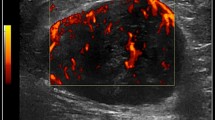Abstract
Ultrasound allows the detection and grading of inflammation in rheumatology. Despite these advantages of ultrasound in the management of rheumatoid patients, it is well known that there are significant machine-to-machine disagreements regarding signal quantification. In this study, we tried to calibrate the power Doppler (PD) signal of two models of ultrasound machines by using a capillary-flow phantom. After flow velocity analysis in the perfusion cartridge at various injection rates (0.1–0.5 ml/s), we measured the signal count in the perfusion cartridge at various injection rates and pulse repetition frequencies (PRFs) by using PD, perfusing an ultrasound micro-bubble contrast agent diluted with normal saline simulating human blood. By use of the data from two models of ultrasound machines, Aplio 500 (Toshiba) and Avius (Hitachi Aloka), the quantitative PD (QPD) index [the summation of the colored pixels in a 1 cm × 1 cm rectangular region of interest (ROI)] was calculated via Image J (internet free software). We found a positive correlation between the injection rate and the flow velocity. In Aplio 500 and Avius, we found negative correlations between the PRF and the QPD index when the flow velocity was constant, and a positive correlation between flow velocity and the QPD index at constant PRF. The equation for the relationship of the PRF between Aplio 500 and Avius was: y = 0.023x + 0.36 [y = PRF of Avius (kHz), x = PRF of Aplio 500 (kHz)]. Our results suggested that the signal calibration of various models of ultrasound machines is possible by adjustment of the PRF setting.






Similar content being viewed by others
References
Newman JS, Adler RS, Bude RO, Rubin JM. Detection of soft-tissue hyperemia: value of power Doppler sonography. AJR Am J Roentgenol. 1994;163:385–9.
Backhaus M, Kamradt T, Sandrock D, et al. Arthritis of the finger joints: a comprehensive approach comparing conventional radiography, scintigraphy, ultrasound, and contrast-enhanced magnetic resonance imaging. Arthritis Rheum. 1999;42:1232–45.
Newman JS, Laing TJ, McCarthy CJ, Adler RS. Power Doppler sonography of synovitis: assessment of therapeutic response—preliminary observations. Radiology. 1996;198:582–4.
Albrecht K, Grob K, Lange U, Muller-Ladner U, Strunk J. Reliability of different Doppler ultrasound quantification methods and devices in the assessment of therapeutic response in arthritis. Rheumatology (Oxford). 2008;47:1521–6.
Koski JM, Saarakkala S, Helle M, Hakulinen U, Heikkinen JO, Hermunen H. Power Doppler ultrasonography and synovitis: correlating ultrasound imaging with histopathological findings and evaluating the performance of ultrasound equipments. Ann Rheum Dis. 2006;65:1590–5.
Terslev L, Torp-Pedersen S, Qvistgaard E, Danneskiold-Samsoe B, Bliddal H. Estimation of inflammation by Doppler ultrasound: quantitative changes after intra-articular treatment in rheumatoid arthritis. Ann Rheum Dis. 2003;62:1049–53.
Torp-Pedersen ST, Terslev L. Settings and artefacts relevant in colour/power Doppler ultrasound in rheumatology. Ann Rheum Dis. 2008;67:143–9.
Kamishima T, Nishida M, Horie T, et al. Power Doppler signal calibration using capillary phantom for pannus vascularity in rheumatoid finger joint. A pilot study. Clin Exp Rheumatol. 2011;29:1057.
Veltmann C, Lohmaier S, Schlosser T, et al. On the design of a capillary flow phantom for the evaluation of ultrasound contrast agents at very low flow velocities. Ultrasound Med Biol. 2002;28:625–34.
Stucker M, Baier V, Reuther T, Hoffmann K, Kellam K, Altmeyer P. Capillary blood cell velocity in human skin capillaries located perpendicularly to the skin surface: measured by a new laser Doppler anemometer. Microvasc Res. 1996;52:188–92.
Acknowledgments
This study was accomplished with a contribution from the Nikkiso Technical Research Institute and Nikkiso Co., Ltd., who provided the perfusion cartridge analyzed, and from Nemoto Kyorindo Co., Ltd., who prepared the angiography injector for this study. This study was supported by a research grant from the Ministry of Education, Culture, Sports, Science, and Technology, Japan.
Conflict of interest
The authors declare that they have no conflict of interest.
Author information
Authors and Affiliations
Corresponding author
About this article
Cite this article
Sakano, R., Kamishima, T., Nishida, M. et al. Power Doppler signal calibration between ultrasound machines by use of a capillary-flow phantom for pannus vascularity in rheumatoid finger joints: a basic study. Radiol Phys Technol 8, 120–124 (2015). https://doi.org/10.1007/s12194-014-0299-5
Received:
Revised:
Accepted:
Published:
Issue Date:
DOI: https://doi.org/10.1007/s12194-014-0299-5




